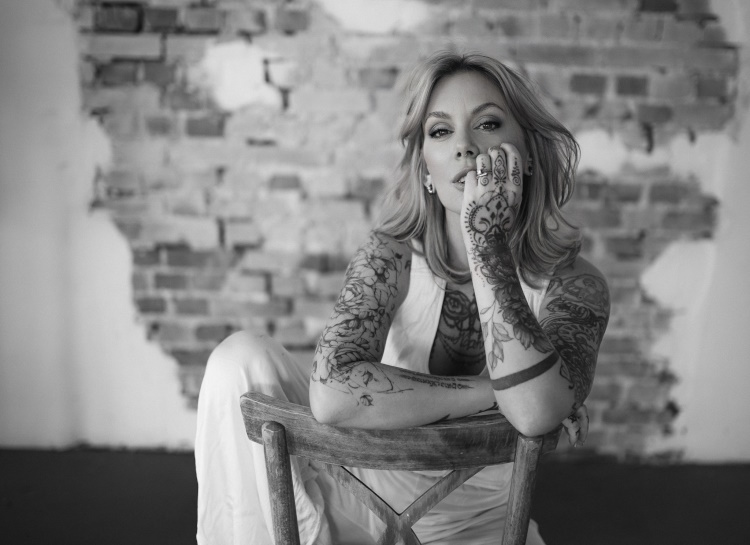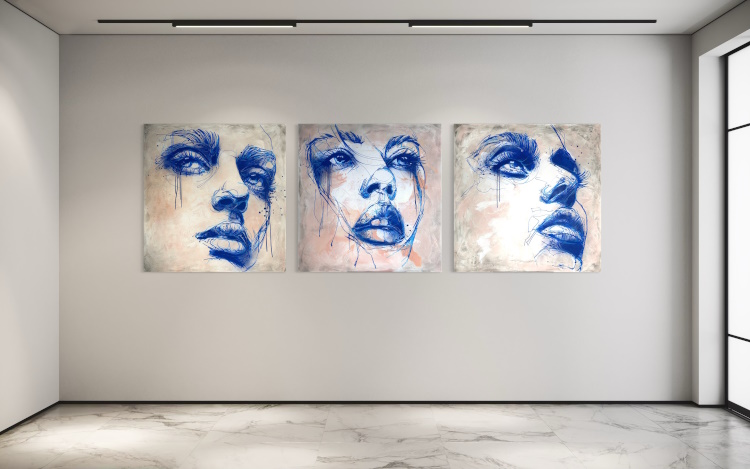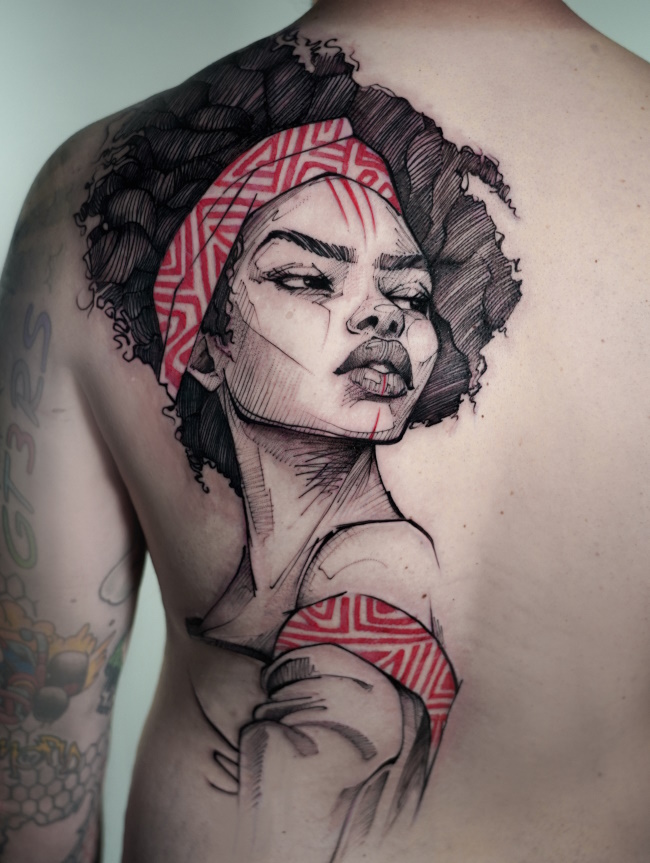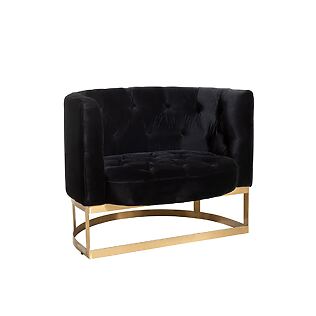Tattoos are no longer only part of a subculture . In the meantime they have found their place in artistic discourse - as an expression of individual aesthetics and personal attitude. Anyone who leaves the limits of classical body art opens up new rooms: for biographical stories, artistic concepts and conscious design. This article illuminates tattoo art as an independent discipline, which is repositioned between sketch block, studio and skin.
The way to art on skin and paper
Artistic practice rarely begins directly on the skin. Often you are preceded by a longer process that starts in the sketchbook, on paper or canvas. Anyone who sees tattoos not only as a service, but as an artistic work, also stays active away from the needle - with pencil, brush or marker. The creative origin lies outdoors in the examination of the shape, line and expression. This is exactly where a style unfolds, which later also wears its handwriting on the skin.
Sketches as the origin - how the drawing pen became the needle
Before the first tattoo is created, pages fill with sketches - fragmentary, intuitive, raw. Drawing is a thinking in lines , a visual exploration of emotion, movement and atmosphere. For many tattooing with artistic standards, these drawings are not an accessory, but the core of their work. They train the eye, train the feeling for proportions and form the basis for complex compositions - be it on paper or skin.

Copyright: Fauve Lex
Sketches serve as a blueprint for their later works - they already contain the emotional tone, the design rhythm and the distinctive style. These preparatory work often becomes their own works of art: as a print, as a graphic or as a series. So the drawing pen always remains present - even if the needle takes over later.
From canvas to skin - the tattoo as another expression medium
Many artists who are at home in visual arts discover the skin as a new projection surface. Tattoo is not a break, but an expansion of the forms of expression. Lines, hatching and surfaces that were created on canvas find their way into body art - adapted to movements, muscle courses and individual anatomies. Art loses nothing here, but wins nearby.
For Fauve, the skin is not a replacement for the canvas, but an equivalent area that makes other challenges. Your free work - whether on paper or as a digital motif - directly influence how she tattooed. It is a dialogue between fixed and lively substrates, between classic aesthetics and the intimacy of tattooed skin. This creates a work that is not only visible, but also noticeable.
Sketch Art - a conscious aesthetics of the unfinished
Sketch Art lives from what is not perfect. Lines overlap, perspectives remain indicated, surfaces incomplete. This is exactly the attraction of this aesthetics - it leaves space for interpretation and creates closeness through the unfinished. Anyone who consciously decides for this style sets a statement: against the smooth, the standardized, for the real one.

Copyright: Fauve Lex
Are typical of the sketch-like style:
- Open line guides that overlap, dissolve or are deliberately not to be overlooked
- Schraffuren instead of smooth surfaces - as an expression of movement, emotion or inner chaos
- Irregularities that are not retouched, but emphasized
- Motif fragments that are only hinted at and thereby promote personal associations
- A visual rawness that does not want to be flawless, but truly
For Fauve Lex, Sketch Art is more than just a style - it is an expression of an attitude that understands the imperfect as actual perfection. ”
Instead of smooth surfaces, it prefers the raw, the unfinished that remains in motion. What becomes visible on the skin bears traces of real stories - open, honest and always alive.

Copyright: Fauve Lex
Emotion is not a concept - but material
Emotions run through the artistic process like a fine fabric - not as a consciously set stylistic device, but as a material that shapes the shape. They are not staged in the Sketch Art, but approved. Fauve Lex does not understand emotion as a concept that is to be illustrated, but as a force that covers. Every line, each stroke wears something personal - sometimes raw, sometimes tender, but always honest.
Personal in shape - without pathos
Feelings find their way into the drawing without becoming loud. No drama, no excess, but a reduced but deep visual language. There are empty areas next to indicated shapes, moved lines meet harmonious structures. In this voltage there is space for individual interpretation - without the aim of wanting to explain something completely. Personal is indicated, not decorated.
The design claim is not to give a story, but to give it a dignified framework and space to interpret. Emotion shows itself in the style, not in the symbol. This makes the difference to many conventional tattoos: they act like an emotional echo , not like an image. Pathos is avoided - not from cold, but out of respect for what is hidden between the lines.
Make stories visible without explaining them
A motif does not have to scream loudly to be understood. A hinted detail is often sufficient, a break in the line, a deliberately set shadow to evoke a memory. Fauve Lex works with visual fragments who answer questions rather than answer. So the tattoo does not become a retelling, but to the public whispering of a very private story.
What is told remains open - and thus protective. People have their experiences on the skin without having to justify them. What becomes visible is often only the surface of a complex inner life. This reluctance is not a lack, but an artistic decision: it leaves the “viewing space” - and protects what does not want to be told.
Draw limitless - what remains if the scene becomes too tight
Scenes can stop - and narrow at the same time. Anyone who works artistically like Fauve Lex but is located in the tattoo scene quickly encounters structural and aesthetic limits. Expectations of style, customers or market logic crash on your own claim that does not want to be adapted but developed. The question is not whether you belong - but what is possible.
Fauve Lex uses the drawing as an anchor point, not the scene. Her work often arises apart from typical studios, shaped by artistic freedom instead of genre rules. Whether as a print, on the skin or canvas - your style remains independent, raw tint, fragmentary. What cannot be classified in drawers is often overlooked - or underestimated. This is precisely this: between the systems, beyond the labels. An expression that remains because it does not adjoin himself.
Keeping behind the needle - responsibility and dialogue
Artistic freedom does not end where responsibility begins - it really starts there. Anyone who works on skin not only designs a motif, but also touches a person in their most vulnerable space. Especially in a field that is often perceived aesthetically or trend -driven, you need to be behind the needle. An attitude that means more than technology: an ethical, interpersonal and professional responsibility.
Between freedom of art and skin health
Tattooing is a physical intervention - with a long -term effect. Therefore, education comes first. Fauve Lex openly informs about healing courses, risks and nursing aspects. Art must be emotional, but never lightly. Especially with sensitive skin conditions, allergies or psychological stress, every decision is made together. The skin tells a story - and it begins long before the first line.
Freedom in the design does not mean arbitrariness. She lives from dialogue with the other person. Not every wish is implemented, not every idea stung immediately. There is a process between impulse and implementation that looks closely, asks and weighs.
Art is not solely created here, but in mindful cooperation - supported by respect for skin, history and borders. "
When expertise belongs to art
Fauve Lex works not only as an artist, but also as a state -recognized expert in the field of tattoos. This knowledge flows into any advice, every assessment. She recognizes skin images, assesses healing processes and names well -founded where medical support is necessary. In complex cases, it is in exchange with dermatologists - not as an exception, but as a standard.
Art is never just an expression. It is also responsible for the body. Therefore, the work does not end with the last needlestick. Aftercare, information and transparency are just as much a part of it, as well as the courage. Anyone who works in this way shows that professionalism and creativity are not a contradiction - but the basis for an art that really gets under the skin.
Conclusion
Tattooing can be more than just body art – it can become an artistic dialogue, a reflection of inner processes, and a conscious act of self-empowerment. Those who work like Fauve Lex combine craftsmanship with attitude, aesthetics with authenticity, and art with a deep understanding of the stories people carry on their skin.
A room is created between the sketch block and the surface of the skin in which emotion, style and responsibility are mutually dependent - without pathos, but with depth.
About the artist
Fauve Lex is an artist, tattoo artist and state -recognized expert for tattoos. Your specialty is the style of the sketch art - a fragmented, sketchy design language that leaves space for personal interpretations. In addition to skin, she also works on paper and canvas. Her works are created in the area of tension between art, empathy and reflection.

Owner and Managing Director of Kunstplaza. Publicist, editor, and passionate blogger in the field of art, design, and creativity since 2011. Successful completion of a degree in web design as part of a university program (2008). Further development of creativity techniques through courses in free drawing, expressive painting, and theater/acting. Profound knowledge of the art market through many years of journalistic research and numerous collaborations with actors/institutions from art and culture.

















